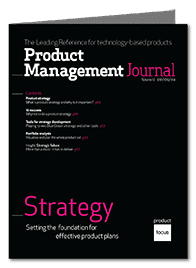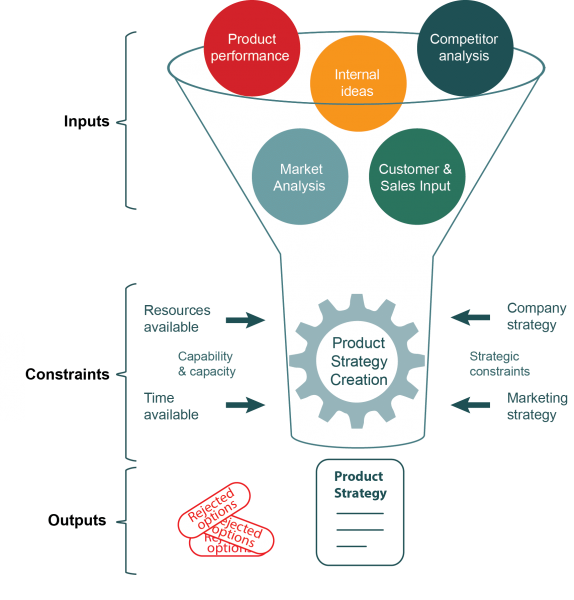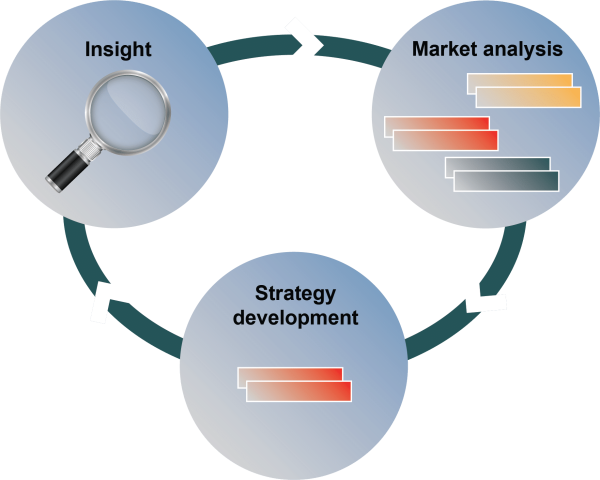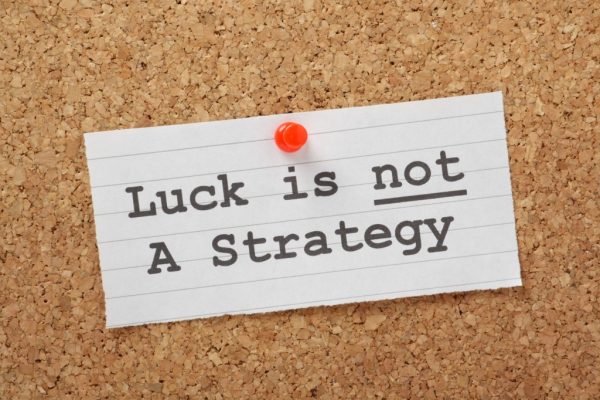 What is product strategy and why is it important?
What is product strategy and why is it important?
Everyone talks about strategy. But what does it really mean to us as product managers?
Very simply, a strategy – any strategy – means deciding what we want to do, and how best to do it. It typically includes an analysis of the current situation, a hypothesis of what we think will happen, some goals, an investigation of options, deciding what we’re going to do, and documenting it all in a plan.
But the word ‘strategy’ is overused, confused, and misused all the time.
You can read all the articles in our Product Management Journal – Strategy by signing up for free here.
Confusion
For example, we’ve heard people say ‘our strategy is to move into the cloud’. This may be a great objective, but it doesn’t say how they’re going to do it!
Some product managers say that their roadmap is their product strategy. Well, there are many documents that could be produced out of product strategy work covering a range of subjects. A roadmap is just one of them. It covers product development, but doesn’t, for example, cover financial or marketing plans.

Some use the words strategy and tactics interchangeably. However, most people consider strategy as answering the high-level question ‘where do we want to go?’ and tactics as the action plans to get there. In crude terms, strategy is using your head to think about things and tactics, your hands to do them.
Others confuse a company strategy and product strategy. That’s fine in the world of start-ups as there is only one product, so the company strategy is the product strategy. However, once you have multiple products in a business then there should be a strategy for each product, as well as for the company. The company strategy sets the overall direction and allocates resources and budgets for the different products. The product strategy explains how you’re going to bring the company strategy to life.
A missing company strategy
Sometimes there is no obvious company strategy. Or, sometimes it’s so high-level it’s difficult to know how it impacts on each product. One response is to prioritize things by whichever customer shouts loudest, or what appears to bring in the most money. However, a better approach is to force-the-issue and develop a product strategy for review by senior management. The assumptions you will need to make about the company strategy should force a discussion and decisions on company priorities.
What is the process?
When working on a product strategy you should consider input from several sources including customers, sales teams, competitive analysis, and market analysis. They can all provide facts and insights to develop your ideas.
Your product strategy will be constrained by other factors. Most importantly it needs to align with the overall company strategy. It also needs to fit with any other strategies and plans that exist. For example, how the business markets to a particular region or how it works with a particular sales channel.
Finally, it needs to work within the capacity and capability constraints within a business i.e., how much resource or money is available. And don’t forget it takes time and effort to do this work.
Most importantly the strategy work needs to result in an output. A presentation or document that can be shared, reviewed, and challenged. And if it’s not to be wasted, it needs to result in some plans. These need to cover all the different aspects of a product – the marketing mix, financial forecast and for a new product, the launch plans.
It’s not just a one-off thing
We live in a world that is constantly changing. We may have developed a product strategy and started to implement our plans, but before long, the market has moved, a competitor has responded, or we’ve learned something new about what our customers want. If the changes are significant then we need to check them against our strategy. Did we take them into account, or is it something unexpected? Do we need to evolve our strategy and plans?
As product managers and product marketers, we’re at the heart of a continuous cycle of getting new insights about our market, analyzing what they mean, and adapting our proposition so we can compete. While you shouldn’t be changing strategy too frequently, having the discipline to do a quarterly or 6 monthly review makes sense.
Is a product strategy the same as a product plan?
Product strategy work should result in some decisions, priority calls and actions. These become the product plan – so product strategy drives the product plan.
The product plan touches on the activities of many areas of a business. Some may be in the remit of you as the product manager, while others may be the responsibility of other areas such as Marketing and Sales. However, all need to be addressed.
What format?
There are lots of free templates to help you document your product plans, but few for the creation of a product strategy. The one below should give you a good start.
When using this high-level Product Strategy Template, pick and choose the sections you need and the level of detail it makes sense to go into. We prefer to use slides as it keeps things concise and ready to present.
How is it typically done?
Product Strategy work is often kicked off by the company’s yearly planning process. Product Management and other departments are asked to submit their plans a month or so in advance of the final target date. Discussion and negotiations typically ensue.
Senior Management set ambitious goals. Development push for more resource. Sales try to get targets lowered and Marketing ask for more money. Product Management is squeezed between these powerful vested interests and eventually, a compromise is reached.
A bid for resource
However, let’s face it, most product strategy work is done as a way of asking for more resources and a bigger focus on the product from the business. It’s an internal sales pitch.
If the pitch is successful it then becomes the plan of record for what’s intended for the product – a yardstick against which to measure progress.
Conclusion
We believe that in many businesses there is often very little product strategy work done. No-one’s quite sure who’s job it is. Or there is no joined-up approach with various departments taking on different aspects. It’s a big gap. It means that product managers spend lots of their time running around dealing with tactical problems – many of which could be avoided if there were clear and agreed product objectives, priorities, and strategies.
A product strategy sets the direction for the business, aligns everyone around common goals and reduces waste. Without one, you’re relying on luck.





